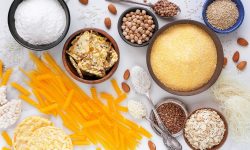Favourite Gluten-Free Items Available at Spud May National Celiac Awareness Month, but every day Spud…
WHAT ARE ANCIENT GRAINS?
Did you know that ancient grains have been consumed by Aztec warriors, offered to the Gods by the Greeks and Romans, and played a fundamental role in the success of the Inca people? The roots of various ancient grains can be traced back hundreds–some, even thousands–of years and most of these grains remain unchanged in the form we continue to eat them in today!
The ancient grains listed below are all gluten free, and full of vitamins, minerals, fibre and antioxidants sometimes hard to obtain when consuming a gluten-free diet (NOTE: Not all ancient grains are gluten free, just the ones discussed here!). Those who omit meat from their life can also turn to ancient grains, as many of these grains are complete proteins, meaning that they contain all nine essential amino acids essential for human nutrition. It’s rare to find this type of protein in plant foods, as they are mostly only found in meat. But what’s the actual nutritional breakdown of these grains, and what’s the best way to serve them? Read on to find out!
AMARANTH
Amaranth was a staple of the Aztec people, and was used both as food and as part of their religious ceremonies. It’s full of calcium, iron, magnesium, potassium, iron, phosphorous, and contains all the essential amino acids to make it a complete protein. Amaranth also has cholesterol lowering properties, which is good for heart health. Try enjoying Amaranth as a breakfast food, as they do in India, Peru and Nepal. It takes on a porridge-like texture when cooked, and will keep you feeling full until lunch!
Nutritional Profile (1 cup cooked)
- Calories: 251
- Fat: 4g
- Sodium 15mg
- Carbohydrates: 46g
- Fibre 5g
- Protein 9g
BUCKWHEAT
People eating Buckwheat can be traced as far back as 4000 B.C. in the Balkan region of Europe. It contains all of the essential amino acids, and is rich in protein, calcium, manganese, potassium, and zinc. Buckwheat groats are great in hot cereals, soups, or as a healthier alternative to refined flour in baked goods. Try out our recipe for Awesome Banana Buckwheat Corn Cakes!
Nutritional Profile: (1 cup uncooked)
- Calories: 583
- Fat: 6g
- Sodium: 2mg
- Carbohydrates: 122g
- Fibre: 17g
- Protein 23g
CHIA SEED
In Mayan, ‘chia’ means ‘strength’. Chia is boasted as one of the main foods in the Aztec diet, and this ancient civilization attributed much of their warriors’ stamina to this tiny seed. They contain a healthy amount of omega 3s and antioxidants, and are incredibly versatile in how they are served. Chia seeds don’t have a very strong flavour, and can be included in recipes to boost nutrition and add texture. They form a gel-consistency when added to liquids, so can be substituted for eggs, added to soups, baked goods, smoothies and more for some added energy. Try out our recipes for Green Chia Seed Pudding, and our Chia Hemp Breakfast Smoothie!
Nutritional Profile: (2Tbsp)
- Calories: 137
- Fat: 9g
- Sodium: 5mg
- Carbohydrates: 12g
- Fibre: 11g
- Protein: 4g
MILLET
Millet is a complex carbohydrate, and prebiotic food, and a staple of the Himalayan Hunzas, people who have enjoyed notable good health and longevity. While millet is high in protein, fibre and B vitamins, the grain also contains serotonin for stress, niacin for lowering cholesterol, and magnesium which helps with migraines. With a subtly sweet, nutty flavour, millet’s texture can range from fluffy to creamy depending on cooking style. It can be cooked into a breakfast porridge, thrown into salads, or added to most meals where you would normally use rice (stirfrys, soups, or side dishes).
Nutritional Profile: (1 cup cooked)
- Calories: 207
- Fat: 2g
- Sodium: 3mg
- Carbs: 41g
- Fibre: 2g
- Protein: 6g
QUINOA
Quinoa was dubbed ‘mother of all grains’ by the Incas, and has been considered a superfood for at least a few millenia. Quinoa is a complete protein, is rich in magnesium, phosphorus, potassium, fibre, and is a good source of calcium for vegans, or those who are lactose-intolerant. Quinoa is also high in antioxidants, and is incredibly easy to incorporate into recipes. Don’t forget that when cooking quinoa, it’s important to rinse off the naturally bitter coating called saponin. Try quinoa under a Vegan Coconut Curry, as a breakfast with Mango Curried Yogurt, in an Apple Chicken or Tofu salad, or in a Tabbouleh or Pea Pilaf!
Nutritional Profile: (1 cup cooked)
- Calories: 222
- Fat: 4g
- Sodium: 13mg
- Carbohydrates: 39g
- Fibre 5g
- Protein 8g
SORGHUM
Sorghum is a staple food in parts of Asia and West Africa, and contains a multitude of health benefits. Sorghum is said to prevent certain types of cancer, help control diabetes, improve digestive health, promote strong bones, and increase red blood cell development. Sorghum is an amazing alternative in rice bowls–try our recipe for Nori Bowls or experiment with your favourite rice bowl recipes! Sorghum also works great served either warm or cold in salads.
Nutritional Profile: (1 cup uncooked)
- Calories: 651
- Fat: 6g
- Sodium: 12mg
- Carbohydrates: 143g
- Fibre: 12g
- Protein: 22g
TEFF
Teff has been a staple quick cooking grain in Ethiopia and Eritrea.This tiny grain is also incredibly tough against harsh environmental conditions including waterlogged areas, high altitudes, dry heat, droughts, and is not prone to plant diseases. It’s also a great source of vitamin C, iron, and protein. Try making a teff porridge for breakfast, use it in place of flour in baked goods, or use it as a base in homemade veggie burgers!
Nutritional Profile: (1 cup uncooked)
- Calories: 708
- Fat: 5g
- Sodium: 23mg
- Carbohydrates: 141g
- Fibre: 15g
- Protein: 26g
If you follow a gluten-free diet, need more plant-based protein, or are looking for a healthier alternative to refined flour, you’ll never regret introducing ancient grains into your meals. What are your favourite ways to use ancient grains?




